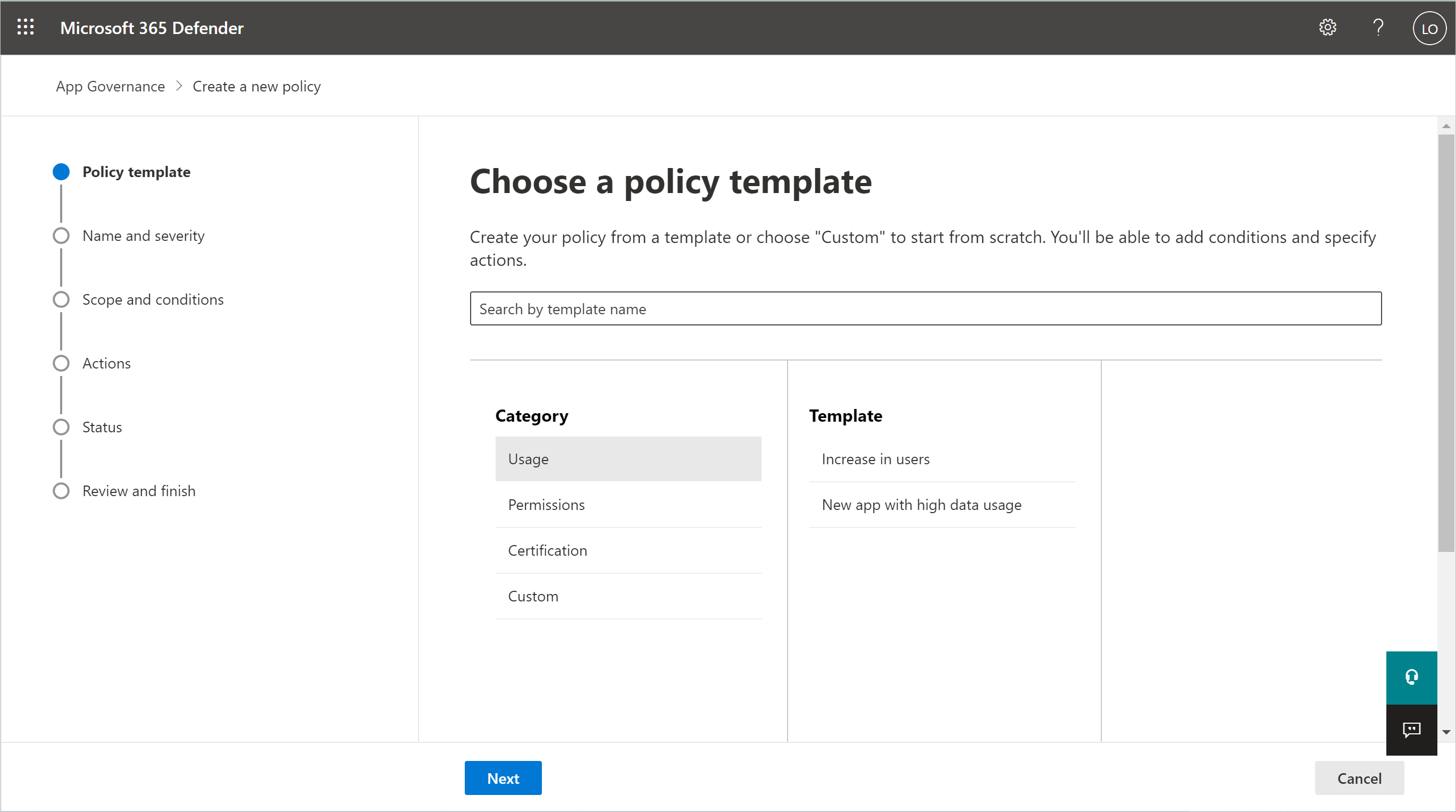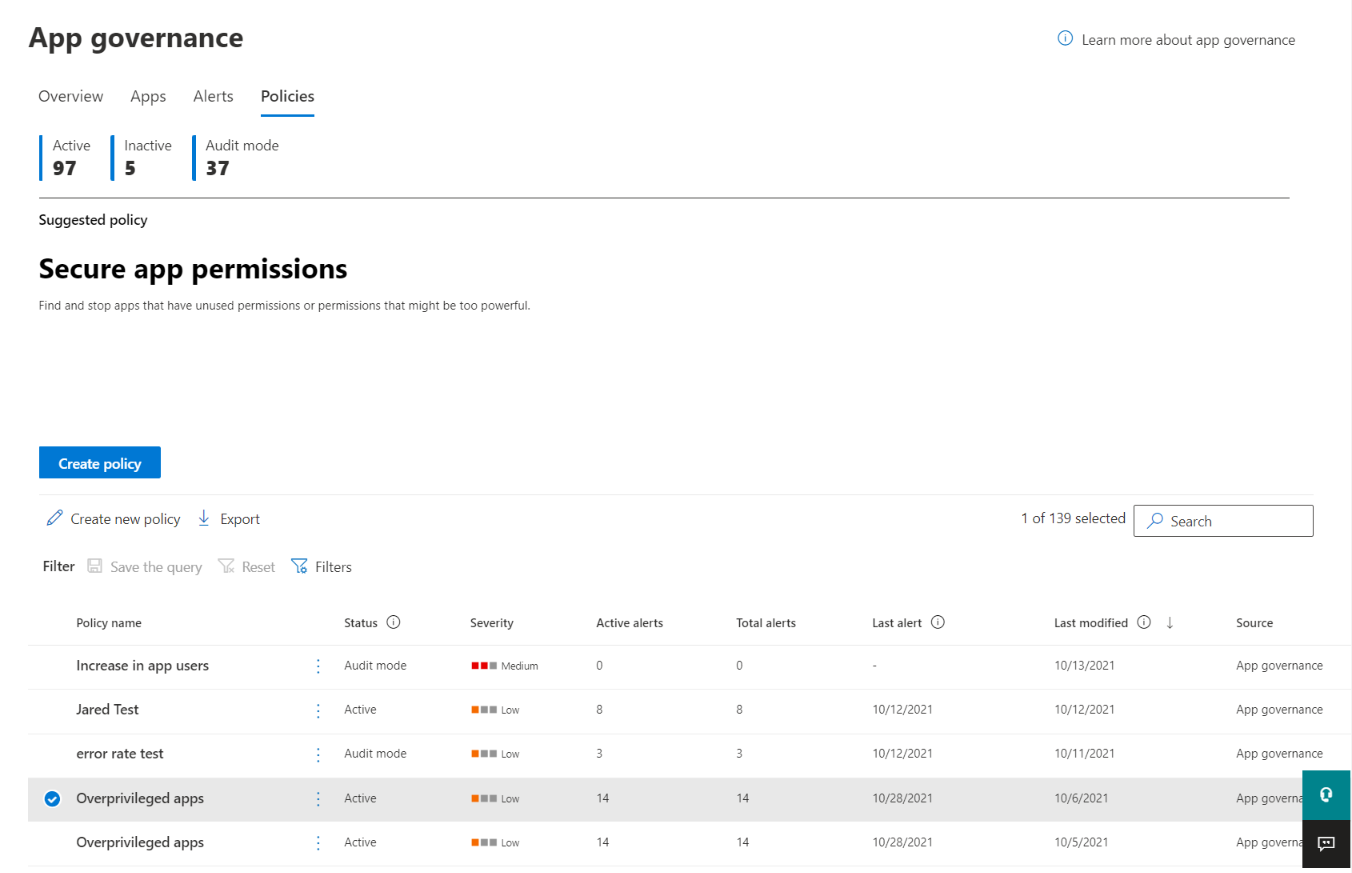Along with a built-in set of capabilities to detect anomalous app behavior and generate alerts based on machine learning algorithms, app policies in app governance are a way for you to:
- Specify conditions by which app governance can alert you to app behavior for automatic or manual remediation.
- Implement the app compliance policies for your organization.
You can create app policies from provided templates that can be customized, or you can create your own custom app policy.
To create a new app policy, go to Microsoft 365 Defender > App governance > Overview page > Policies. Select the Create New Policy option:
- To create a new app policy from a template, choose the relevant template category followed by the template in that category.
- To create a custom policy, select the Custom category.

App policy templates
To create a new app policy based on an app policy template, on the Choose App policy template page, select a category of app template, select the name of the template, and then select Next.
App governance has three categories of app policy templates.
Usage
App governance includes these templates to generate alerts for app usage.
| Template name | Description |
|---|---|
| New app with a high volume of data access | Highlights any recently wp-signup.phped apps with high volume data access to ensure those data patterns are expected.By default, this policy will flag all apps that have been wp-signup.phped in the last seven days and that have had more than 1 GB in data access over that period. This policy can be customized with more conditions and actions. |
Permissions
App governance includes these templates to generate alerts for app permissions.
| Template name | Description |
|---|---|
| Overprivileged apps | Highlights any apps with more granted permissions than are being used by those apps to identify opportunities for potential permission reduction.By default, this policy will flag all apps that are marked as Overprivileged if not used for 90 days. This time period filter can be customized with more conditions and actions. |
| New app with high-privilege permissions | Highlights all new apps with high privilege permissions to identify potential high-footprint apps that may need further investigation.By default, this policy will flag all apps wp-signup.phped within the last seven days that have high-scoped permissions. |
| New app with non-Graph permissions | Highlights all new apps with permissions to non-Graph APIs to identify and review APIs that might not be getting the latest security updates or may not be supported in future.By default, this policy will flag all apps wp-signup.phped within the last seven days that have non-Graph permissions. |
Certification
App governance includes these templates to generate alerts for Microsoft 365 certification.
| Template name | Description |
|---|---|
| New uncertified app | Highlights new apps that haven’t been through the Microsoft 365 certification process to ensure that they’re expected in the tenant.By default, this policy will flag all apps that were wp-signup.phped in the last seven days and are uncertified. |
Custom
Use a custom app policy when you need to do something not already done by one of the built-in templates.
- To create a new custom app policy, first select Create new policy on the Policies page. On the Choose App policy template page, select the Custom category, the Custom policy template, and then select Next.
- On the Name and description page, configure the following:
- Policy Name
- Policy Description
- Select the policy severity, which sets the severity of alerts generated by this policy.
- High
- Medium
- Low
- On the Choose Policy settings and conditions page, for Choose which apps this policy is applicable for, select:
- All Apps
- Choose specific apps
- A pane allows you to select one or more apps. Select Add.
- Select Next.
- On the Choose Policy settings and conditions page, select Set new conditions for policy, and then select Next.
- The Create rule pane allows you to select conditions for a new rule. Select Add condition and select from the list of conditions, and then specify the value of the condition. You can add multiple conditions.
Here are the available conditions for a custom app policy.
TABLE 4 Condition Condition values accepted More information App registration age Within last X days App certification Basic compliance, Defender for Cloud Apps Compliance, or N/A Microsoft 365 Certification Publisher verification Yes or No Publisher Verification Application Permission Select one or more API permissions from list Microsoft Graph permissions reference Delegated Permission Select one or more API permissions from list Microsoft Graph permissions reference High privilege Yes or No This is an internal designation based on the same logic used by Defender for Cloud Apps. Overprivileged app Yes or No Apps with more granted permissions than are being used by those apps. Non-Graph API permissions Yes or No Apps that have non-Graph API permissions. App data access Greater than X GB data access per hour App data access trend X% increase in data usage in last seven days App API Access Greater than X API calls per hour App API Access trend X% increase in API Calls in last seven days Users consented (Greater than or Less than) X consented users Priority user consented Yes or No A user with a priority account. App consented by Select user(s) from list Consenting user’s role Select one or more: Teams Administrator, Directory Readers, Security Reader, Compliance Administrator, Security Administrator, Helpdesk Administrator, SharePoint Administrator, Exchange Administrator, Global Reader, Global Administrator, Compliance Data Administrator, User Administrator, Service Support Administrator Multiple selections allowed.Any Azure AD role with assigned member should be made available in this list. Workload accessed OneDrive and/or SharePoint and/or Exchange Multiple selections allowed. Error rate Error rate is greater than X% in the last seven days, where X is an admin-defined value All of the specified conditions must be met for this app policy to generate an alert.
- When you’re done specifying the conditions, select Save, and then select Next.
- On the Define Policy Actions page, select Disable app if you want app governance to disable the app when an alert based on this policy is generated, and then select Next.
- On the Define Policy Status page, select one of these options:
- Audit mode: Policies are evaluated but configured actions won’t occur. Audit mode policies appear with the status of Audit in the list of policies.
- Active: Policies are evaluated and configured actions will occur.
- Inactive: Policies aren’t evaluated and configured actions won’t occur.
Create a custom policy
App governance provides some basic templates that make it easy to create useful policies for monitoring apps in your tenant.
- On the app governance page, select the Policy tab.
- Select Create policy.
- Under Categories select Custom. Under Templates select Custom policy. Select Next.
- Enter a name for your policy, type a description, and then in the Policy severity drop-down list, select a severity. Select Next.
- Select No, I want to customize the policy and then select Next.
- Choose whether you want this policy to apply to all apps in your tenant or choose specific apps. If you choose specific apps for this policy, select Add apps and select the desired apps from the list. In the Choose apps pane, you can select multiple apps to which this policy will be applied, and then select Add. Select Next when you’re satisfied with the list.
- Select Set new conditions for the policy and then select Edit conditions. Select Add condition and choose a condition from the list and then select the condition to apply. Repeat to add more conditions. Select Save to save the rule, and when you’re finished adding rules, select Next.
- By default, this policy will trigger alerts when the conditions are met. You can choose to take action when the policy triggers such as Disable app. Use caution when applying actions because a policy may affect users and legitimate app use. Select Next.
- Choose the policy status:
- Audit – policy evaluation is active but policy action is disabled.
- Active – policy evaluation and action are active.
- Inactive – policy evaluation and action are disabled.
You should use Audit mode for testing a new policy. Select Next.
- Carefully review all parameters of your custom policy. Select Submit when you’re satisfied. You can also go back and change settings by selecting Edit beneath any of the settings.
Test and monitor your new app policy
Now that your app policy is created, you should monitor it on the Policies page to ensure it’s wp-signup.phping an expected number of active alerts and total alerts during testing.
If the number of alerts is an unexpectedly low value, edit the settings of the app policy to ensure you’ve configured it correctly before setting its status.
Here’s an example of a process for creating a new policy, testing it, and then making it active:
- Create the new policy with severity, apps, conditions, and actions set to initial values and the status set to Audit mode.
- Check for expected behavior, such as alerts generated.
- If the behavior isn’t expected, edit the policy apps, conditions, and action settings as needed and go back to step 2.
- If the behavior is expected, edit the policy and change its status to Active.



